Analysis of Extreme Temperature Variations on the Yunnan-Guizhou Plateau in Southwestern China over the Past 60 Years
Abstract
:1. Introduction
2. Materials and Methods
2.1. Study Area and Data Description
2.2. Methods
2.2.1. Definition of Extreme Temperature
2.2.2. Trend Analysis
2.2.3. Correlation Analysis
3. Results
3.1. Temporal Variation in Extreme Temperature Indices
3.1.1. Absolute Indices (TXx, TXn, TNx, and TNn)
3.1.2. Percentile Indices (TX90p, TX10p, TN90p, and TN10p)
3.1.3. Other Indices (FD, SU, DTR, and TR)
3.1.4. Temporal Variations of Extreme Temperature Indices during 1960–1989 and 1990–2019
3.2. Spatial Variation in Extreme Temperature
3.2.1. Absolute Indices (TXx, TXn, TNx, and TNn)
3.2.2. Percentile Indices (TX90p, TX10p, TN90p, and TN10p)
3.2.3. Other Indices (FD, SU, DTR, and TR)
3.3. Impacts of Geographical Factors on Extreme Temperature
3.4. Association of Extreme Temperatures with ACPs
4. Discussion
5. Conclusions
Author Contributions
Funding
Institutional Review Board Statement
Informed Consent Statement
Data Availability Statement
Conflicts of Interest
References
- Deng, Y.; Jiang, W.; He, B.; Chen, Z.; Jia, K. Change in intensity and frequency of extreme precipitation and its possible teleconnection with large-scale climate index over the China from 1960 to 2015. J. Geophys. Res. Atmos. 2018, 123, 2068–2081. [Google Scholar] [CrossRef]
- Seddon, A.W.R.; Macias-Fauria, M.; Long, P.R.; Benz, D.; Willis, K.J. Sensitivity of global terrestrial ecosystems to climate variability. Nature 2016, 531, 229–232. [Google Scholar] [CrossRef] [PubMed] [Green Version]
- Piao, S.L.; Ciais, P.; Huang, Y.; Shen, Z.H.; Peng, S.S.; Li, J.S.; Zhou, L.P.; Liu, H.Y.; Ma, Y.C.; Ding, Y.H.; et al. The impacts of climate change on water resources and agriculture in China. Nature 2010, 467, 43–51. [Google Scholar] [CrossRef] [PubMed]
- Han, J.; Miao, C.; Duan, Q.; Wu, J.; Lei, X.; Liao, W. Variations in start date, end date, frequency and intensity of yearly temperature extremes across China during the period 1961–2017. Environ. Res. Lett. 2020, 15, 045007. [Google Scholar] [CrossRef]
- IPCC. Climate Change 2021: The Physical Science Basis. In Contribution of Working Group I to the Sixth Assessment Report of the Intergovernmental Panel on Climate Change; Cambridge Press: Cambridge, UK, 2021. [Google Scholar]
- Sun, Y.; Zhang, X.; Zwiers, F.W.; Song, L.; Wan, H.; Hu, T.; Yin, H.; Ren, G. Rapid increase in the risk of extreme summer heat in Eastern China. Nat. Clim. Change 2014, 4, 1082–1085. [Google Scholar] [CrossRef]
- Sharma, P.J.; Loliyana, V.D.; R., R.S.; Timbadiya, P.V.; Patel, P.L. Spatiotemporal trends in extreme rainfall and temperature indices over Upper Tapi Basin, India. Theor. Appl. Climatol. 2018, 134, 1329–1354. [Google Scholar] [CrossRef]
- Sun, Q.; Miao, C.; AghaKouchak, A.; Mallakpour, I.; Ji, D.; Duan, Q. Possible Increased Frequency of ENSO-Related Dry and Wet Conditions over Some Major Watersheds in a Warming Climate. Bull. Am. Meteorol. Soc. 2020, 101, E409–E426. [Google Scholar] [CrossRef]
- Zhao, N.; Chen, M. A Comprehensive Study of Spatiotemporal Variations in Temperature Extremes across China during 1960–2018. Sustainability 2021, 13, 3807. [Google Scholar] [CrossRef]
- Wang, B.; Liu, D.L.; Macadam, I.; Alexander, L.V.; Abramowitz, G.; Yu, Q. Multi-model ensemble projections of future extreme temperature change using a statistical downscaling method in south eastern Australia. Clim. Chang. 2016, 138, 85–98. [Google Scholar] [CrossRef]
- Shi, J.; Cui, L.; Ma, Y.; Du, H.; Wen, K. Trends in temperature extremes and their association with circulation patterns in China during 1961–2015. Atmospheric Res. 2018, 212, 259–272. [Google Scholar] [CrossRef]
- Lhotka, O.; Kyselý, J. Hot Central-European summer of 2013 in a long-term context. Int. J. Clim. 2015, 35, 4399–4407. [Google Scholar] [CrossRef]
- Adams, R.E.; Lee, C.C.; Smith, E.T.; Sheridan, S.C. The relationship between atmospheric circulation patterns and extreme temper-ature events in North America. Int. J. Climatol. 2021, 41, 92–103. [Google Scholar] [CrossRef]
- Jiang, S.; Chen, X.; Smettem, K.; Wang, T. Climate and land use influences on changing spatiotemporal patterns of mountain vegetation cover in southwest China. Ecol. Indic. 2020, 121, 107193. [Google Scholar] [CrossRef]
- Gu, F.; Gou, X.H.; Deng, Y.; Su, J.J.; Lin, W.; Yu, A.L. Analysis of temperature variations over the Yunnan-Guizhou Plateau from 1960 to 2014. J. Lanzhou Univ. (Nat. Sci.) 2018, 54, 721–730. (In Chinese) [Google Scholar] [CrossRef]
- Lu, H.; Ding, L.; Ma, Z.; Li, H.; Lu, T.; Su, M.; Xu, J. Spatiotemporal assessments on the satellite-based precipitation products from fengyun and GPM over the Yunnan-Kweichow Plateau, China. Earth Space Sci. 2020, 7, e2019EA000857. [Google Scholar] [CrossRef]
- Yan, W.; He, Y.; Cai, Y.; Cui, X.; Qu, X. Analysis of Spatiotemporal Variability in Extreme Climate and Potential Driving Factors on the Yunnan Plateau (Southwest China) during 1960–2019. Atmosphere 2021, 12, 1136. [Google Scholar] [CrossRef]
- Li, Y.-G.; He, D.; Hu, J.-M.; Cao, J. Variability of extreme precipitation over Yunnan Province, China 1960–2012. Int. J. Clim. 2014, 35, 245–258. [Google Scholar] [CrossRef]
- Wang, X.; Li, Y.; Wang, M.; Li, Y.; Gong, X.; Chen, Y.; Chen, Y.; Cao, W. Changes in daily extreme temperature and precipitation events in mainland China from 1960 to 2016 under global warming. Int. J. Clim. 2020, 41, 1465–1483. [Google Scholar] [CrossRef]
- Wang, S.; Lu, S. A rock magnetic study on red palaeosols in Yun-Gui Plateau (Southwestern China) and evidence for uplift of Plateau. Geophys. J. Int. 2013, 196, 736–747. [Google Scholar] [CrossRef] [Green Version]
- Lu, H.; Huang, Z.; Ding, L.; Lu, T.; Yuan, Y. Calibrating FY4A QPE using CMPA over Yunnan–Kweichow Plateau in summer 2019. Eur. J. Remote Sens. 2021, 54, 476–486. [Google Scholar] [CrossRef]
- dos Santos, C.A.C.; Neale, C.M.U.; Mekonnen, M.M.; Gonçalves, I.Z.; de Oliveira, G.; Ruiz-Alvarez, O.; Safa, B.; Rowe, C.M. Trends of extreme air temperature and precipitation and their impact on corn and soybean yields in Nebraska, USA. Arch. Theor. Appl. Climatol. 2022, 147, 1379–1399. [Google Scholar] [CrossRef]
- Ding, Z.; Pu, J.; Meng, L.; Lu, R.; Wang, Y.; Li, Y.; Dong, Y.; Wang, S. Asymmetric trends of extreme temperature over the Loess Plateau during 1998–2018. Int. J. Clim. 2020, 41, E1663–E1685. [Google Scholar] [CrossRef]
- Wang, P.; Tang, J.; Sun, X.; Wang, S.; Wu, J.; Dong, X.; Fang, J. Heat Waves in China: Definitions, Leading Patterns, and Connections to Large-Scale Atmospheric Circulation and SSTs. J. Geophys. Res. Atmos. 2017, 122, 10679–10699. [Google Scholar] [CrossRef]
- Zhang, K.X.; Dai, S.P.; Dong, X.G. Dynamic Variability in Daily Temperature Extremes and Their Relationships with Large-scale Atmospheric Circulation During 1960–2015 in Xinjiang, China. Chin. Geogr. Sci. 2020, 30, 233–248. [Google Scholar] [CrossRef] [Green Version]
- Alexander, L.V.; Zhang, X.B.; Peterson, T.C.; Caesar, J.; Gleason, B.; Klein Tank, A.M.; Haylock, M.; Collins, D.; Trewin, B.; Rahimzadeh, F.; et al. Global observed changes in daily climate extremes of temperature and precipitation. J. Geophys. Res. Atmos. 2006, 111, 1042–1063. [Google Scholar] [CrossRef] [Green Version]
- Finkel, J.M.; Katz, J.I. Changing world extreme temperature statistics. Int. J. Clim. 2017, 38, 2613–2617. [Google Scholar] [CrossRef] [Green Version]
- Thirumalai, K.; DiNezio, P.N.; Okumura, Y.; Deser, C. Extreme temperatures in Southeast Asia caused by El Niño and worsened by global warming. Nat. Commun. 2017, 8, 15531. [Google Scholar] [CrossRef] [PubMed]
- Guan, Y.; Zhang, X.; Zheng, F.; Wang, B. Trends and variability of daily temperature extremes during 1960–2012 in the Yangtze River Basin, China. Glob. Planet. Chang. 2015, 124, 79–94. [Google Scholar] [CrossRef] [Green Version]
- Mann, H.B. Nonparametric tests against trend. Econometrica 1945, 13, 245–259. [Google Scholar] [CrossRef]
- Kendall, M.G. Rank Correlation Methods; Charles Griffin and Company: London, UK, 1975. [Google Scholar]
- Yatim, A.N.M.; Latif, M.T.; Ahamad, F.; Khan, F.; Nadzir, M.S.M.; Juneng, L. Observed trends in extreme temperature over the Klang Valley, Malaysia. Adv. Atmospheric Sci. 2019, 36, 1355–1370. [Google Scholar] [CrossRef]
- Hadri, A.; Saidi, M.; Saouabe, T.; El Alaoui El Fels, A. Temporal trends in extreme temperature and precipitation events in an arid area: Case of Chichaoua Mejjate region (Morocco). J. Water Clim. Change 2021, 14, 895–915. [Google Scholar] [CrossRef]
- Dunn, R.J.H.; Alexander, L.V.; Donat, M.G.; Zhang, X.; Bador, M.; Herold, N.; Lippmann, T.; Allan, R.; Aguilar, E.; Barry, A.A.; et al. Development of an Updated Global Land in Situ-Based Data Set of Temperature and Precipitation Extremes: HadEX3. J. Geophys. Res. Atmos. 2020, 125, e2019JD032263. [Google Scholar] [CrossRef]
- Sun, W.; Mu, X.; Song, X.; Wu, D.; Cheng, A.; Qiu, B. Changes in extreme temperature and precipitation events in the Loess Plateau (China) during 1960–2013 under global warming. Atmos. Res. 2016, 168, 33–48. [Google Scholar] [CrossRef]
- Ding, Z.; Wang, Y.; Lu, R. An analysis of changes in temperature extremes in the Three River Headwaters region of the Tibetan Plateau during 1961–2016. Atmos. Res. 2018, 209, 103–114. [Google Scholar] [CrossRef]
- Zongxing, L.; He, Y.; Wang, P.; Theakstone, W.H.; An, W.; Wang, X.; Lu, A.; Zhang, W.; Cao, W. Changes of daily climate extremes in southwestern China during 1961–2008. Glob. Planet. Change 2012, 80–81, 255–272. [Google Scholar] [CrossRef]
- Zhang, Q.; Xu, C.-Y.; Zhang, Z.; Chen, X.; Han, Z. Precipitation extremes in a karst region: A case study in the Guizhou province, southwest China. Theor. Appl. Climatol. 2009, 101, 53–65. [Google Scholar] [CrossRef]
- Liu, X.D.; Cheng, Z.G.; Yan, L.B.; Yin, Z.Y. Elevation dependency of recent and future minimum surface air temperature trends in the Tibetan Plateau and its surroundings. Glob. Planet. Change 2009, 68, 164–174. [Google Scholar] [CrossRef]
- Kukal, M.; Irmak, S. Long-term patterns of air temperatures, daily temperature range, precipitation, grass reference evapotranspiration and aridity index in the USA great plains: Part II. Temporal trends. J. Hydrol. 2016, 542, 978–1001. [Google Scholar] [CrossRef] [Green Version]
- Vose, R.S.; Easterling, D.R.; Gleason, B. Maximum and minimum temperature trends for the globe: An update through 2004. Geophys. Res. Lett. 2005, 32, L23822. [Google Scholar] [CrossRef] [Green Version]
- Hegerl, G.C.; Zwiers, F.W.; Stott, P.A.; Kharin, V.V. Detectability of anthropogenic changes in annual temperature and precipitation extremes. J. Clim. 2004, 17, 3683–3700. [Google Scholar] [CrossRef] [Green Version]
- Kamae, Y.; Li, X.; Xie, S.-P.; Ueda, H. Atlantic effects on recent decadal trends in global monsoon. Clim. Dyn. 2017, 49, 3443–3455. [Google Scholar] [CrossRef] [Green Version]
- Zhao, L.; Oppenheimer, M.; Zhu, Q.; Baldwin, J.W.; Ebi, K.L.; Bou-Zeid, E.; Guan, K.; Liu, X. Interactions between urban heat islands and heat waves. Environ. Res. Lett. 2018, 13, 034003. [Google Scholar] [CrossRef]
- Zhong, K.; Zheng, F.; Wu, H.; Qin, C.; Xu, X. Dynamic changes in temperature extremes and their association with atmospheric circulation patterns in the Songhua River Basin, China. Atmos. Res. 2017, 190, 77–88. [Google Scholar] [CrossRef]
- Marshall, G.J.; Jylhä, K.; Kivinen, S.; Laapas, M.; Dyrrdal, A.V. The role of atmospheric circulation patterns in driving recent changes in indices of extreme seasonal precipitation across Arctic Fennoscandia. Clim. Change 2020, 162, 741–759. [Google Scholar] [CrossRef]
- Horton, D.E.; Johnson, N.C.; Singh, D.; Swain, D.L.; Rajaratnam, B.; Diffenbaugh, N.S. Contribution of changes in atmospheric circulation patterns to extreme temperature trends. Nature 2015, 522, 465–469. [Google Scholar] [CrossRef] [PubMed] [Green Version]
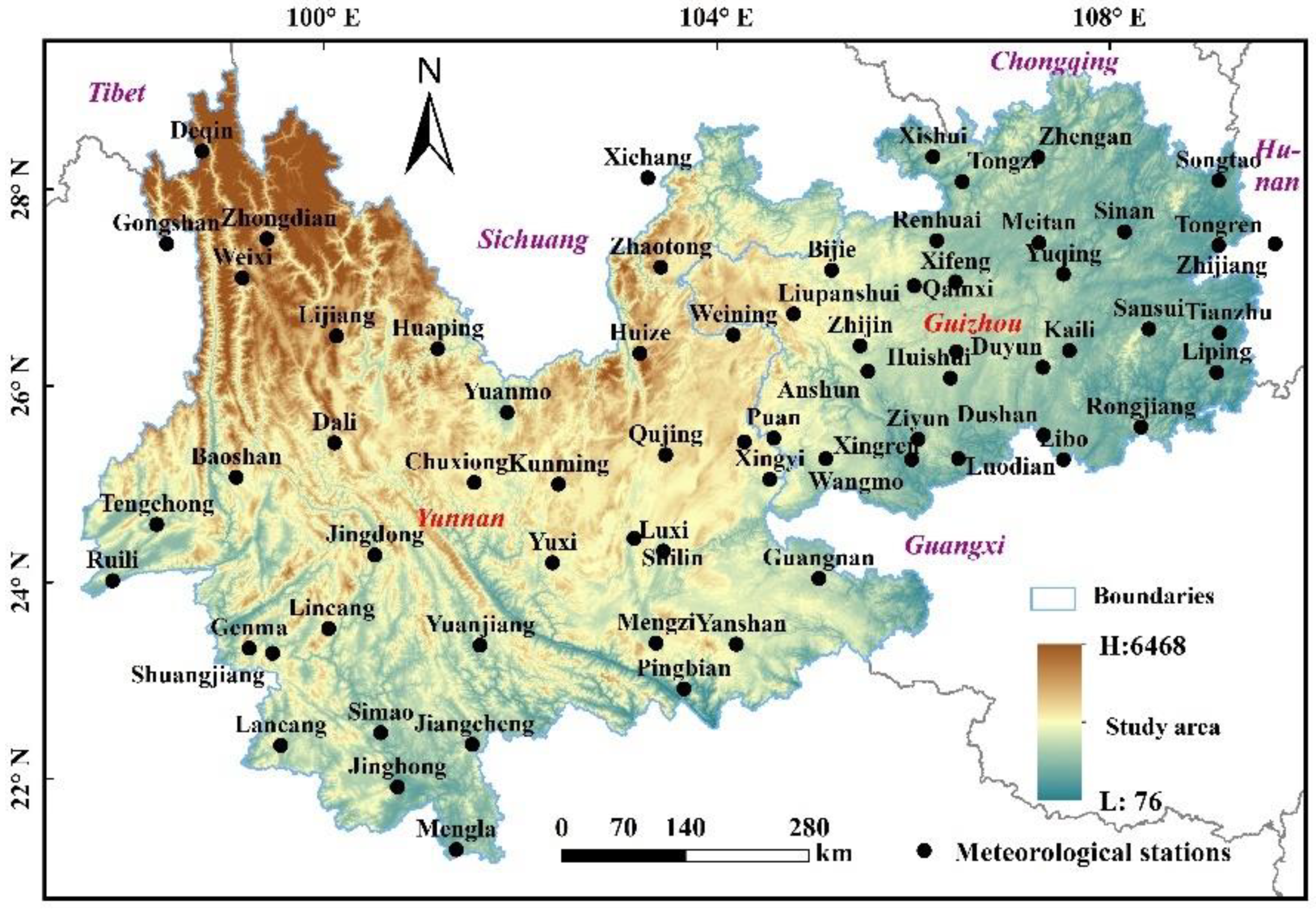
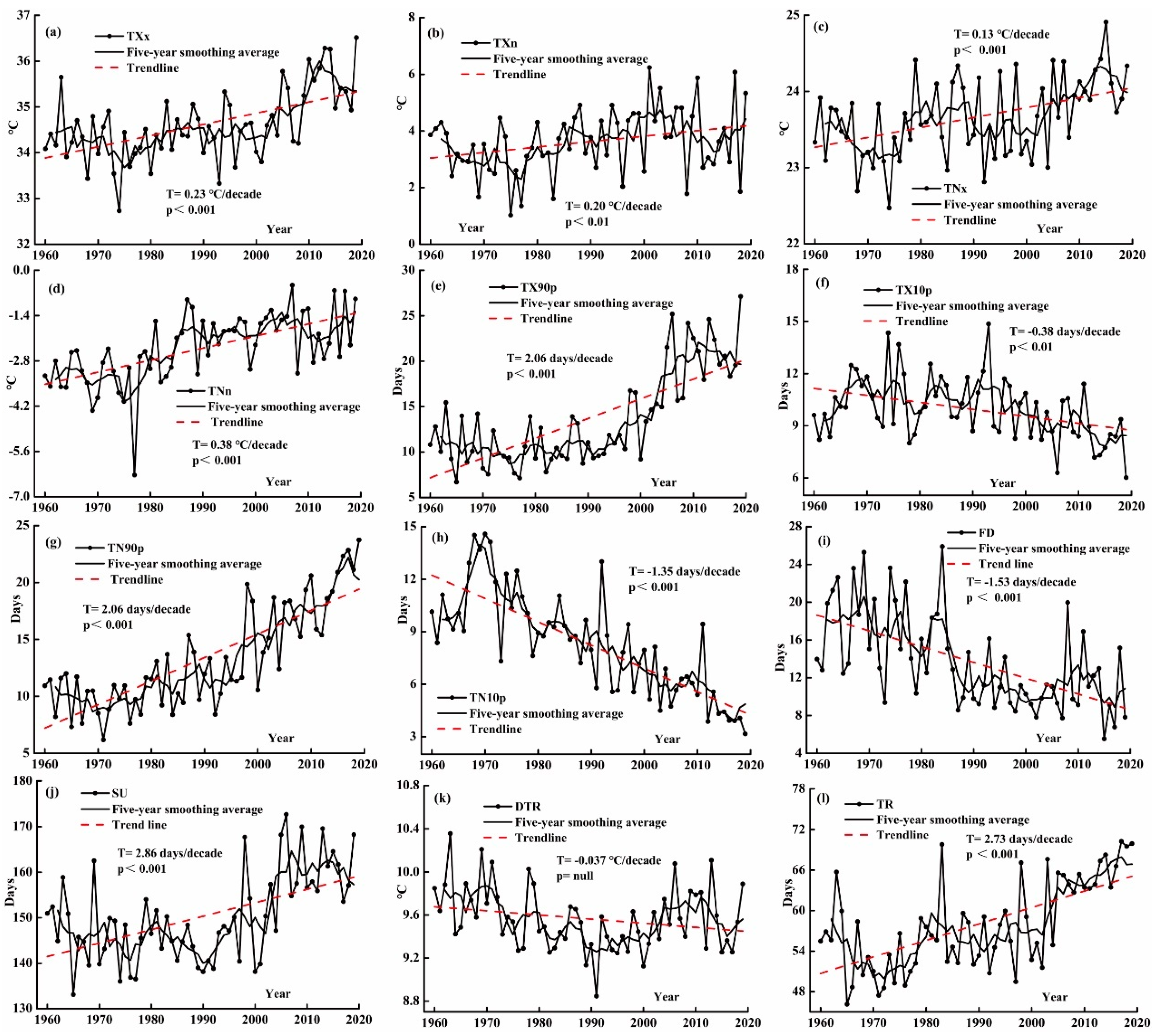
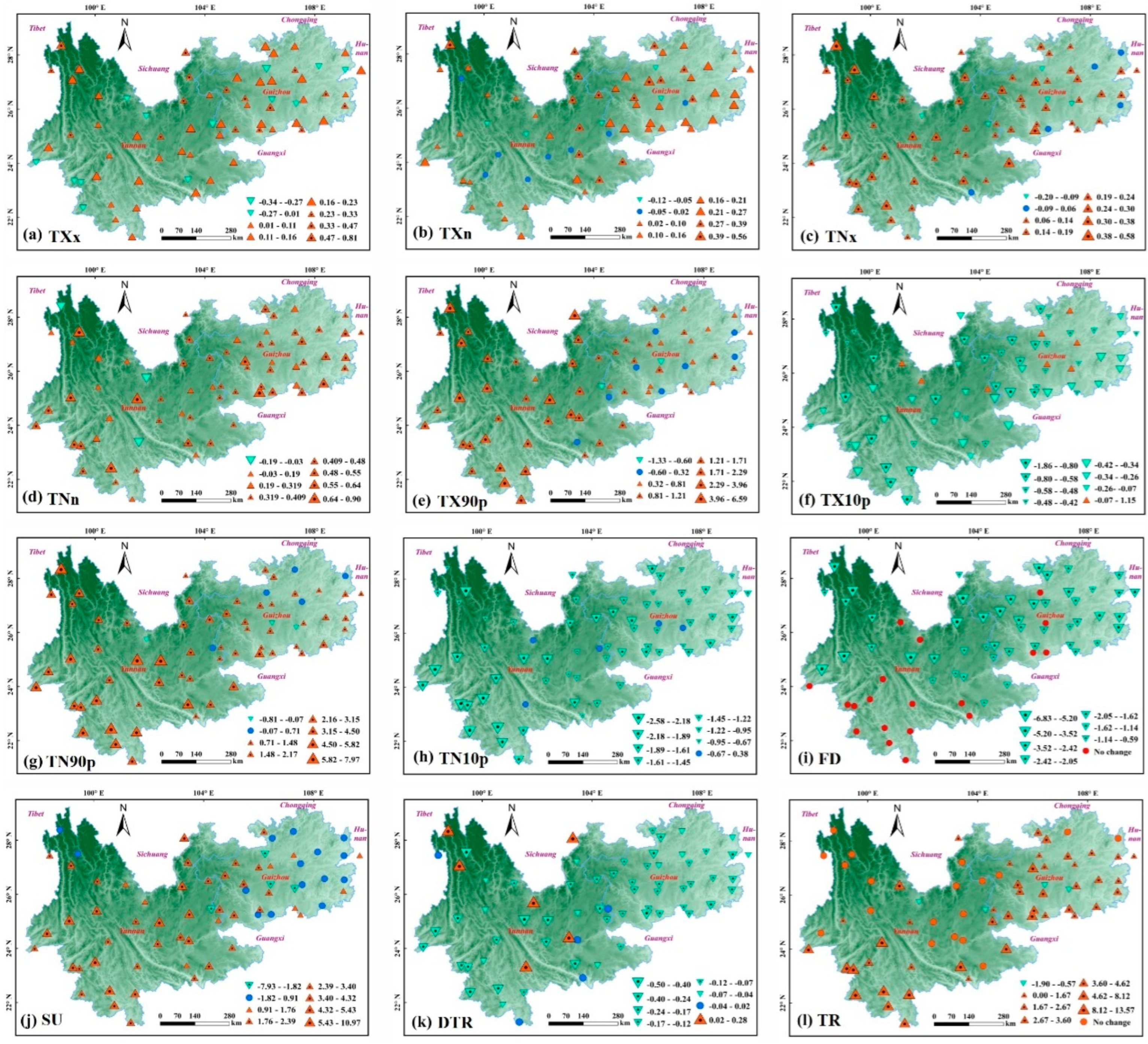
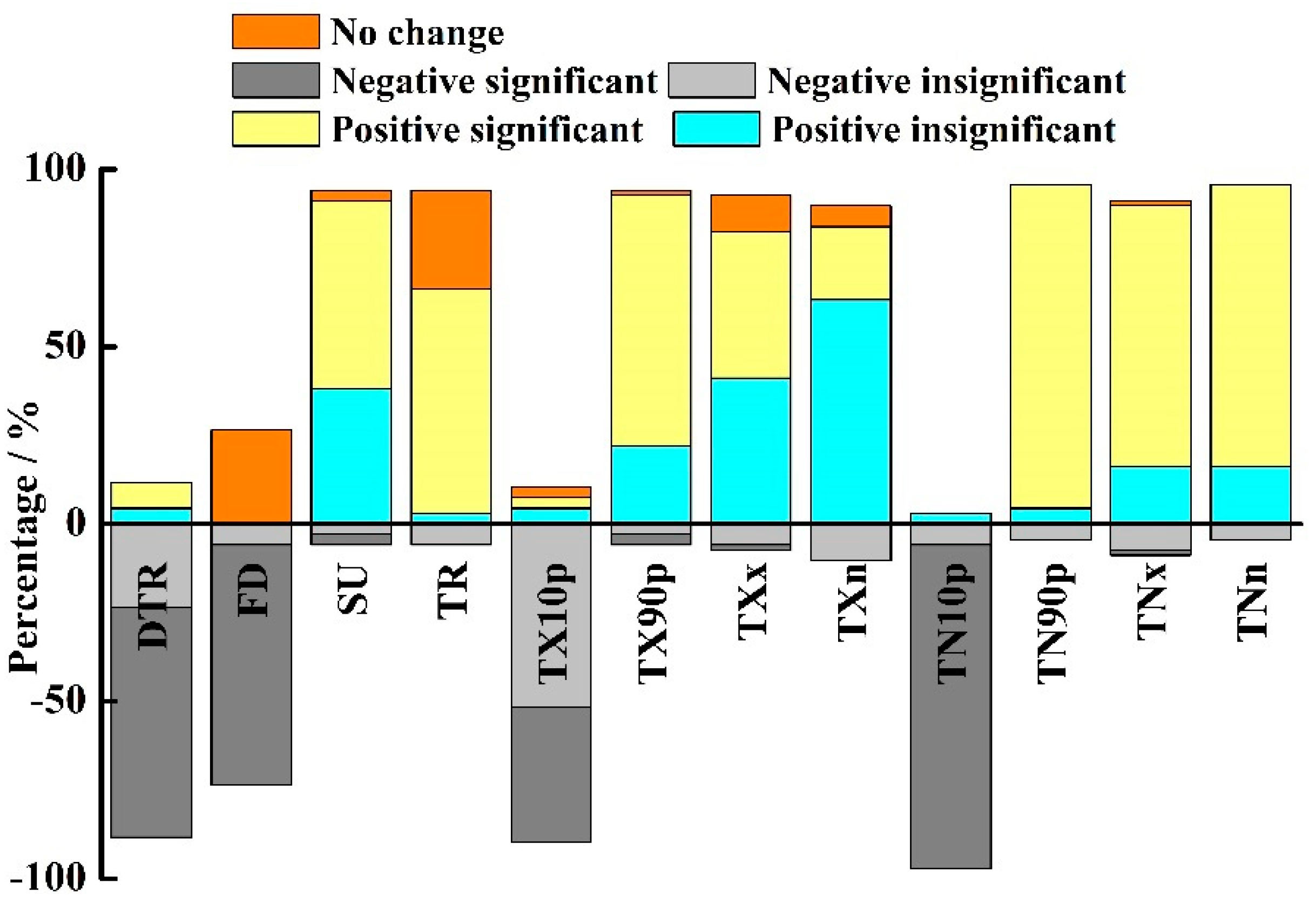
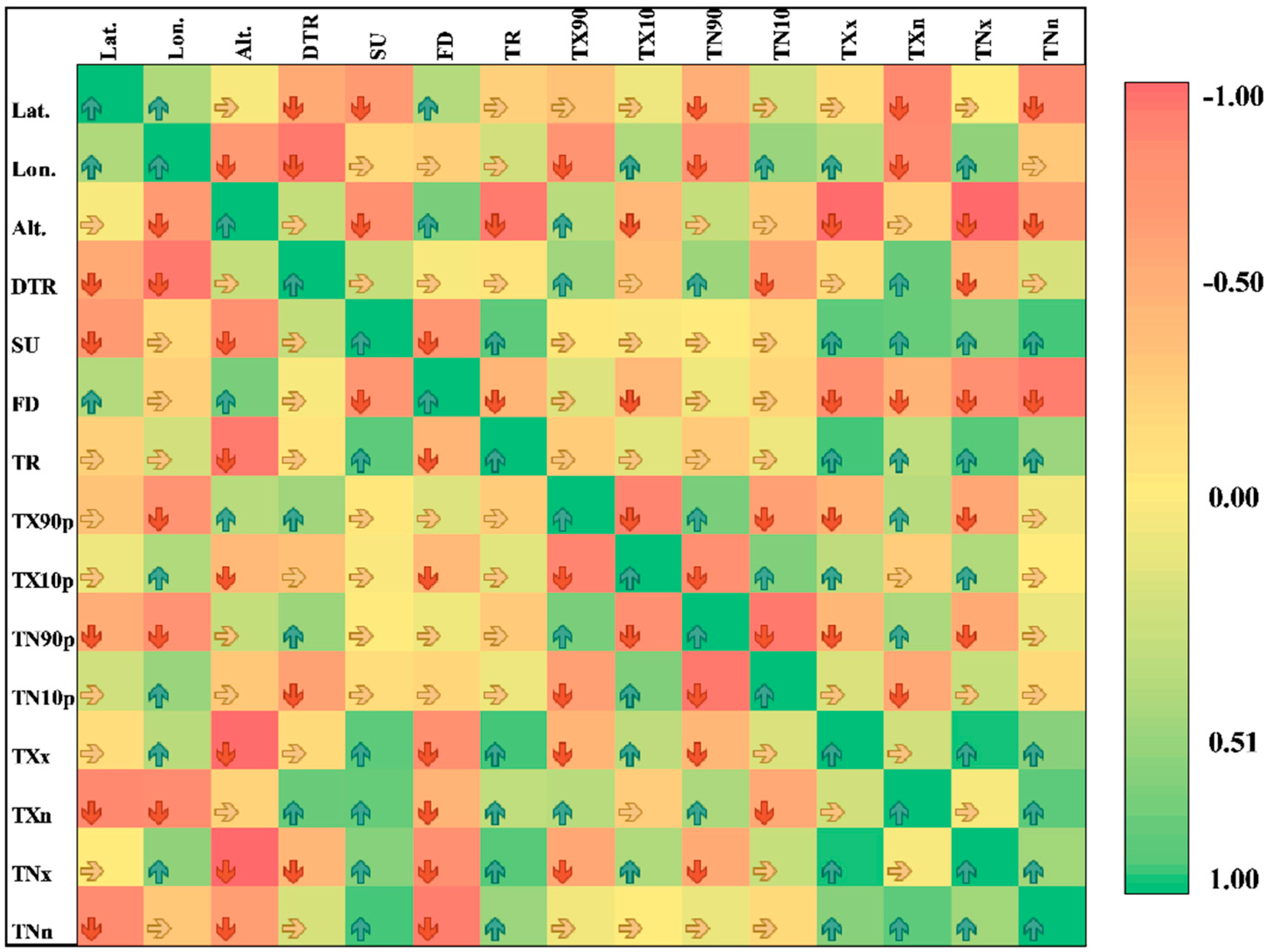
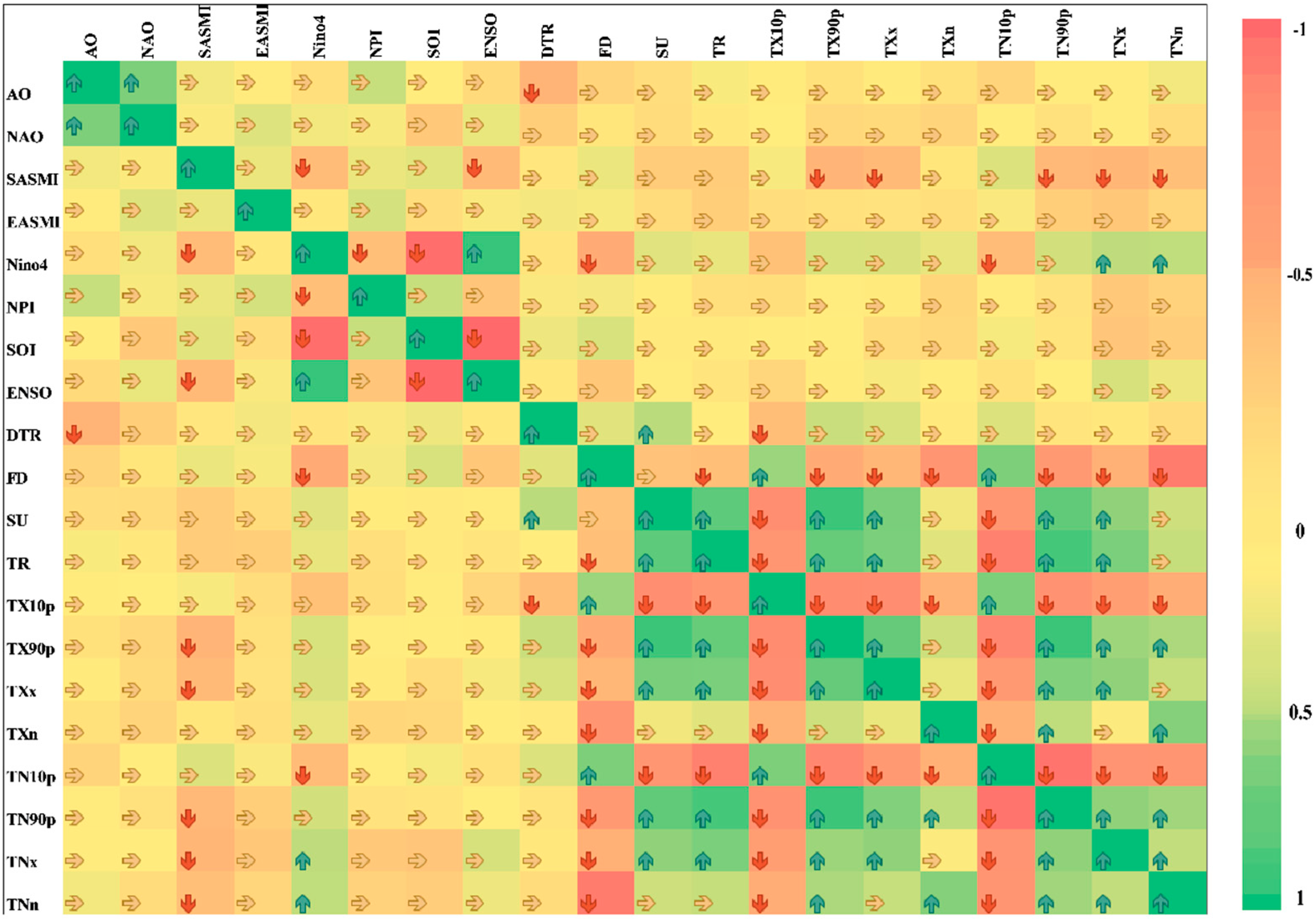
| Category | Index | Description Name | Definitions | Unit |
|---|---|---|---|---|
| Absolute indices | TXx | The hottest day | The maximum value of TX records | °C |
| TXn | Warmest day | The minimum value of TX records | °C | |
| TNn | The coldest night | The minimum value of TN records | °C | |
| TNx | Warmest night | The maximum value of TN records | °C | |
| Percentile indices | TN10p | Cold nights | Days when TN < 10th percentile | days |
| TX10p | Cold days | Days when TX < 10th percentile | days | |
| TN90p | Warm nights | Days when TN > 90th percentile | days | |
| TX90p | Warm days | Days when TX >90th percentile | days | |
| Other indices | FD | Frost days | Annual count of days where TN < 0 °C | days |
| SU | Summer days | Annual count of days where TX > 25 °C | days | |
| TR | Tropical nights | Annual count of days where TN > 20 °C | days | |
| DTR | Diurnal temperature range | Annual mean difference between TX and TN | °C |
| Indices | 1960–1969 | 1970–1979 | 1980–1989 | 1990–1999 | 2000–2009 | 2010–2019 |
|---|---|---|---|---|---|---|
| DTR (°C) | 9.81 | 9.66 | 9.43 | 9.34 | 9.56 | 9.59 |
| FD (days) | 18.41 | 16.32 | 15.28 | 10.93 | 10.62 | 10.67 |
| SU (days) | 148.37 | 143.95 | 145.28 | 147.19 | 155.61 | 160.66 |
| TR (days) | 55.04 | 51.74 | 55.82 | 56.68 | 60.49 | 66.61 |
| TX10p (days) | 10.27 | 10.66 | 10.74 | 10.58 | 9.22 | 8.33 |
| TX90p (days) | 11.22 | 9.61 | 10.40 | 11.81 | 17.00 | 21.38 |
| TXx (°C) | 34.37 | 34.05 | 34.45 | 34.40 | 34.65 | 35.72 |
| TXn (°C) | 3.28 | 2.84 | 3.62 | 3.88 | 4.22 | 3.84 |
| TN10p (days) | 10.88 | 11.17 | 9.11 | 7.67 | 6.18 | 4.81 |
| TN90p (days) | 10.18 | 9.26 | 11.46 | 13.01 | 15.87 | 20.06 |
| TNx (°C) | 23.44 | 23.36 | 23.71 | 23.52 | 23.69 | 24.17 |
| TNn (°C) | −3.28 | −3.47 | −2.36 | −1.99 | −1.64 | −1.81 |
| Indices | 1960–1989 | 1990–2018 | Values of 1960–1989 | Values of 1990–2019 | Difference | Indices | 1960– 1989 | 1990–2018 | Values of 1960–1989 | Values of 1990–2019 | Difference |
|---|---|---|---|---|---|---|---|---|---|---|---|
| DTR | −0.02 ** | 0.01 * | 9.63 | 9.50 | −0.13 | TXx | 0.01 | 0.06 ** | 34.29 | 34.92 | 0.63 |
| FD | −0.15 | −0.02 | 16.67 | 10.74 | −5.93 | TXn | 0.01 | 0.00 | 3.25 | 3.98 | 0.73 |
| SU | −0.19 | 0.81 ** | 145.86 | 154.49 | 8.62 | TN10p | −0.08 * | −0.14 ** | 10.39 | 6.22 | −4.17 |
| TR | 0.09 | 0.52 ** | 54.55 | 61.26 | 6.71 | TN90p | 0.06 | 0.40 ** | 10.30 | 16.31 | 6.01 |
| TX10p | 0.03 | −0.11 ** | 10.56 | 9.37 | −1.18 | TNx | 0.01 | 0.03 ** | 23.50 | 23.80 | 0.29 |
| TX90p | −0.02 | 0.45 ** | 10.41 | 16.73 | 6.32 | TNn | 0.04 * | 0.02 | −3.04 | −1.81 | 1.22 |
| Altitude | Stations | DTR | FD | SU | TR | TX90p | TX10p | TN90p | TN10p | TXx | TXn | TNx | TNn |
|---|---|---|---|---|---|---|---|---|---|---|---|---|---|
| 0–500 | 9 | 8.6 | 7.9 | 182.4 | 119.7 | 11.7 | 10.1 | 12.6 | 8.7 | 37.8 | 3.6 | 26.6 | −1.4 |
| 500–1000 | 14 | 8.6 | 10.7 | 175.0 | 96.6 | 12.8 | 10.1 | 13.4 | 8.5 | 35.6 | 4.1 | 25.0 | −1.4 |
| 1000–1500 | 21 | 7.5 | 14.1 | 172.2 | 22.0 | 11.3 | 9.7 | 12.5 | 8.6 | 31.6 | −0.1 | 22.1 | −3.4 |
| 1500–2000 | 18 | 10.0 | 23.0 | 103.9 | 1.1 | 12.3 | 10.1 | 15.0 | 8.5 | 30.7 | 1.7 | 19.6 | −4.0 |
| 2000–2500 | 4 | 10.9 | 54.6 | 44.0 | 0.0 | 12.8 | 9.7 | 14.8 | 8.2 | 29.2 | 1.7 | 17.6 | −6.4 |
| 3000–3500 | 2 | 11.6 | 166.5 | 0.4 | 0.0 | 17.1 | 8.3 | 18.6 | 7.1 | 23.9 | −0.7 | 12.1 | −14.4 |
Publisher’s Note: MDPI stays neutral with regard to jurisdictional claims in published maps and institutional affiliations. |
© 2022 by the authors. Licensee MDPI, Basel, Switzerland. This article is an open access article distributed under the terms and conditions of the Creative Commons Attribution (CC BY) license (https://creativecommons.org/licenses/by/4.0/).
Share and Cite
Zhang, K.; Luo, J.; Peng, J.; Zhang, H.; Ji, Y.; Wang, H. Analysis of Extreme Temperature Variations on the Yunnan-Guizhou Plateau in Southwestern China over the Past 60 Years. Sustainability 2022, 14, 8291. https://doi.org/10.3390/su14148291
Zhang K, Luo J, Peng J, Zhang H, Ji Y, Wang H. Analysis of Extreme Temperature Variations on the Yunnan-Guizhou Plateau in Southwestern China over the Past 60 Years. Sustainability. 2022; 14(14):8291. https://doi.org/10.3390/su14148291
Chicago/Turabian StyleZhang, Kexin, Jiajia Luo, Jiaoting Peng, Hongchang Zhang, Yan Ji, and Hong Wang. 2022. "Analysis of Extreme Temperature Variations on the Yunnan-Guizhou Plateau in Southwestern China over the Past 60 Years" Sustainability 14, no. 14: 8291. https://doi.org/10.3390/su14148291
APA StyleZhang, K., Luo, J., Peng, J., Zhang, H., Ji, Y., & Wang, H. (2022). Analysis of Extreme Temperature Variations on the Yunnan-Guizhou Plateau in Southwestern China over the Past 60 Years. Sustainability, 14(14), 8291. https://doi.org/10.3390/su14148291





